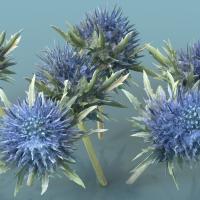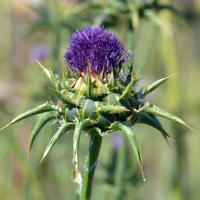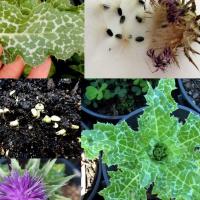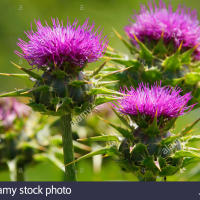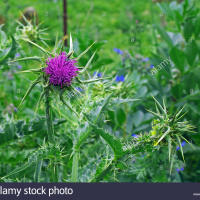Milk thistle
Silybum marianum
Description:
Milk Thistle (Silybum marianum) is a robust and spiny biennial or annual herbaceous plant belonging to the Asteraceae family. Native to the Mediterranean region, it has become naturalized in many parts of the world. Here is a detailed description of its appearance:
-
Height and Structure:
- Size: Milk Thistle can grow up to 5 feet (1.5 meters) in height.
- Structure: It has a distinctive appearance with large, glossy, dark green leaves that are lobed and armed with spines along the edges. The leaves often have white marbling.
-
Flowers:
- Color: The flowers of Milk Thistle are vibrant purple to pink and can grow up to 4 cm in diameter.
- Arrangement: The flowers are clustered at the ends of the branched stems.
-
Fruits:
- Seed Head: The mature plant produces a characteristic seed head, which is a spiky, spherical structure. The seeds are brown and have a pappus of silky hairs.
Identification:
Identifying Milk Thistle involves recognizing key features:
-
Leaves: The large, dark green leaves are glossy, lobed, and have white marbling. They are armed with spines along the edges.
-
Stem: The stem is tall, branched, and often has a whitish hue.
-
Flowers: The vibrant purple to pink flowers are clustered at the ends of the stems and have a distinctive spiky appearance.
-
Seed Head: The mature seed head is spiky, spherical, and contains brown seeds with silky hairs.
Management:
Milk Thistle can be a troublesome weed, especially in agricultural and disturbed areas. Effective management involves a combination of methods:
-
Mechanical Control:
- Regular mowing or cutting before seed set can help prevent the spread.
- Hand pulling or digging out small infestations, wearing protective gloves due to the spines.
-
Chemical Control:
- Herbicides, particularly those targeting broadleaf weeds, can be effective. Consult with local agricultural extension services for appropriate herbicides and application guidelines.
-
Prevention:
- Monitoring and early intervention are crucial to prevent the establishment and spread of Milk Thistle.
- Implementing good land management practices to reduce disturbances that favor its growth.
In conclusion, Silybum marianum (Milk Thistle) is a distinctive weed known for its spiky appearance and characteristic leaves. Effective management involves a proactive approach, combining mechanical control, chemical intervention, and preventive measures to limit its impact on ecosystems and agricultural settings.




